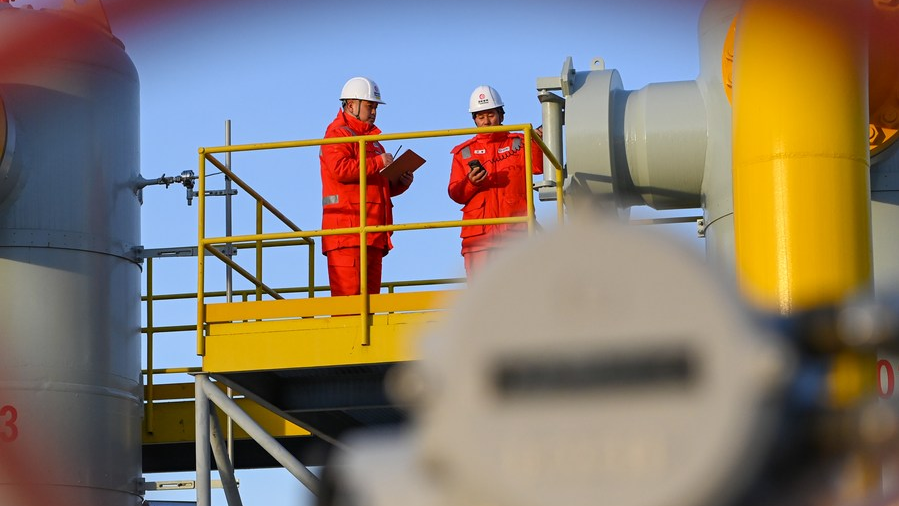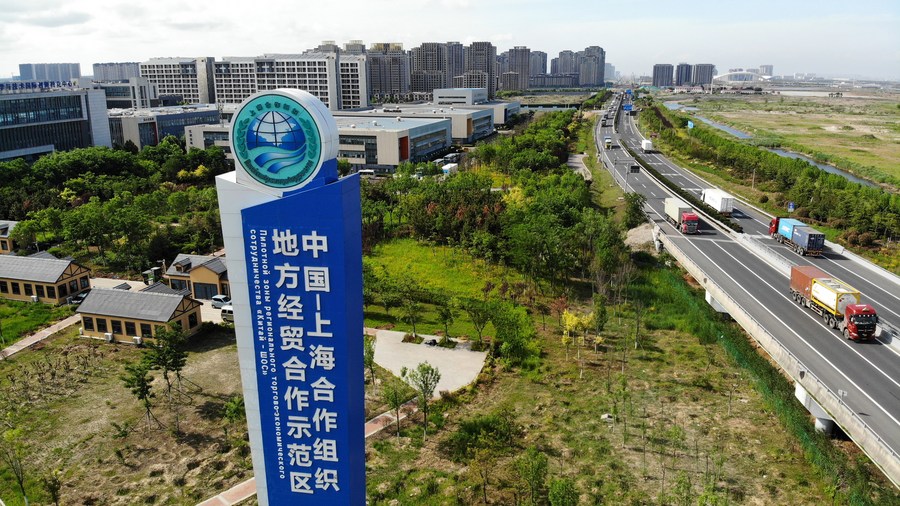As flagship projects of oil and gas cooperation between China and Kazakhstan, the China-Kazakhstan Crude Oil Pipeline and the China-Central Asia Gas Pipeline traverse the vast desert.
The two crude oil pipelines and four natural gas pipelines between China and Kazakhstan have became a masterpiece of connectivity of energy infrastructure under the Belt and Road cooperation, building a bridge of friendship to further deepen mutually beneficial cooperation between China and Central Asian countries, including Kazakhstan.
Energy is an important area of cooperation among the member states of the Shanghai Cooperation Organization (SCO), which was established in Shanghai in 2001 on the basis of mutual benefits and win-win results, and continues to expand the "cake of cooperation."
Established by China, Kazakhstan, Kyrgyzstan, Russia, Tajikistan and Uzbekistan, the SCO has expanded from a regional organization with six members into a global organization with nine full members, three observer countries, and 14 dialogue partners, covering over 60 percent of the Eurasian landmass and nearly half of the world's population.
As of 2021, the total economic volume of the SCO has increased more than 13 times since its establishment, and the total foreign trade volume has increased 100 times compared with 20 years ago.
Chinese Premier Li Qiang will attend the 22nd Meeting of the Council of Heads of Government of SCO Member States in Bishkek, Kyrgyzstan from October 24 to 27, to have in-depth exchange of views on the SCO Development Strategy and formulate concrete measures on cooperation in such areas as security, economy and trade, connectivity and people-to-people exchanges.

Maintenance workers are on patrol inspection at the Horgos initial compressor station, the first station of the China-Central Asia natural gas pipeline in China, northwest China's Xinjiang Uygur Autonomous Region, February 4, 2021. /Xinhua
Maintenance workers are on patrol inspection at the Horgos initial compressor station, the first station of the China-Central Asia natural gas pipeline in China, northwest China's Xinjiang Uygur Autonomous Region, February 4, 2021. /Xinhua
SCO development driven by Belt and Road cooperation
Moving from project cooperation to the alignment of development strategies, cooperation among SCO countries has expanded from the bilateral to multilateral level to stimulate regional economic vitality.
Driven by the Belt and Road cooperation, the SCO countries have devoted themselves to development, and gradually formed a "two-wheel drive" situation of security and economy, achieving leaps and bounds in economic development and trade connectivity.
In 2009, the heads of state of China, Turkmenistan, Uzbekistan and Kazakhstan jointly inaugurated the China-Central Asia natural gas pipeline. Because a section of the pipeline network runs parallel to the ancient Silk Road, the pipeline has been dubbed the "new silk road of energy."
Through Horgos, a border city in northwest China's Xinjiang Uygur Autonomous Region, gas from Central Asia connects to China's West-to-East Gas Pipeline which transmits the gas further to various Chinese regions, including Shanghai, Fuzhou and Hong Kong.
The Horgos station delivered about 43 billion cubic meters of Central Asian natural gas via the pipeline in 2022, Xinhua reported, accounting for 11.8 percent of China's consumption in the same year.
Through cooperation in the natural gas sector with China, Central Asian countries are also tapping into the huge energy market.
"In Kazakhstan and Uzbekistan, we have created more than 11,000 temporary positions and provided over 1,600 long-term jobs. Over the course of the 30-year operational span of the pipeline, it is also expected to generate tens of billions of dollars in tax revenue," said Meng Xiangdong, executive director of Sino-Pipeline International Company.
During the China-Central Asia Summit held in May this year, China proposed to forge a China-Central Asia energy development partnership, increase oil and gas trade, develop energy cooperation across the industrial chain, and boost cooperation in new energy and for the peaceful use of nuclear energy.
Meanwhile, "a community of development for us all" is taking shape. Major projects such as the China-Pakistan Economic Corridor and SCO training and demonstration base for agricultural technology exchange have brought tangible benefits for local people.
China has promised to establish a China-SCO base for training counter-terrorism personnel, set up a China-SCO Big Data Cooperation Center and provide developing countries in need with emergency humanitarian assistance of grain and other supplies worth 1.5 billion yuan (about $214 million). Its commitments to the SCO not only benefit the region but also lead a broader range of practical cooperation.

The China-SCO Local Economic and Trade Cooperation Demonstration Area in Qingdao, east China's Shandong Province, May 31, 2023. /Xinhua
The China-SCO Local Economic and Trade Cooperation Demonstration Area in Qingdao, east China's Shandong Province, May 31, 2023. /Xinhua
Sharing open opportunities, promoting common development
The China-SCO Local Economic and Trade Cooperation Demonstration Area (SCODA) in Qingdao, east China's Shandong Province, has grown into a new and promising platform for the Belt and Road cooperation.
First proposed in June 2018, the SCODA is becoming an important link in international industrial, supply and trade chains, boosting economic and trade cooperation among the SCO countries.
It is also a zone for industrial cooperation, having attracted more than 70 projects with a total investment of over 200 billion yuan (about $27.9 billion).
Earlier this year, several Kazakh enterprises reached a cooperation intention agreement with the SCODA to set up a trading center in Qingdao for specialty agricultural products from Kazakhstan.
"We chose to cooperate with the SCODA because of its good geographical location, which offers huge sea, rail and air transport advantages," said Manarbek Tulegenov, chairman of EUROLOG LLP, a Kazakh logistics company. He added that entering the Chinese market is in the company's strategic plan.
The demonstration area features a comprehensive economic and trade platform to offer one-stop services covering trade, customs clearance, logistics and finance. Nearly 5,000 enterprises have registered on the platform.
The SCODA has also either introduced or nurtured 10 trading platforms, linking more than 2,000 trading companies in doing so.
In addition, the SCO expo in June this year attracted 330 enterprises and institutions from 34 countries and regions, displaying more than 10,000 kinds of commodities from SCO countries, making it a big stage for the Belt and Road cooperation.
As a unique economic and trade zone for the SCO countries, the SCODA has massive potential and plays a key role in promoting new technologies and technology conversion in the SCO countries and boosting international economic and trade cooperation, said Hakimov Masum, from Uzbekistan's Tashkent State Transport University.